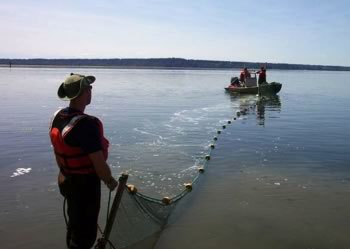Fish Monitoring Methods

Beach seine sampling, Nisqually estuary.
Fish are often the primary driver for estuarine restoration because they are signatures of the health and productivity of estuarine systems. As secondary consumers, fish integrate the functioning of lower trophic levels and are sensitive to physical system attributes (e.g., dissolved oxygen, hydrologic connectivity).
In Puget Sound, several estuarine-dependent fishes are federally listed under the Endangered Species Act, highlighting the need estuary restoration. Fish are ecologically and culturally important to the recovery of Puget Sound and the cultural heritage of its native peoples.
In the Nisqually estuary, our interdisciplinary monitoring framework enables us to link key estuarine processes with habitat development and biological response of fishes based on three critical restoration performance metrics: opportunity, capacity, and realized function (Ellings and Hodgson 2007; Simenstad et al. 2006; Gelfenbaum et al. 2006; Simenstad and Cordell 2000).
- Opportunity to access restored habitats
- Capacity of restored habitats to support fish through improved conditions and prey resources
- Realized Function integration of opportunity and capacity; the measureable responses of fish to restored habitat (e.g., foraging, growth, and residence time)
These performance metrics are measured through physical and ecological monitoring along with fish based studies including:
- assessing pre- and post-restoration fish community composition
- salmonid spatial and temporal distribution
- relative abundance of all fishes
- prey availability and diet composition
The methods employed to answer these questions include:
References
Hayes, D. B., Ferreri, C. P. and Taylor, W.W., 1996. Active fish capture methods. Pages 193-220 in B. R. Murphy and D. W. Willis, editors. Fisheries techniques, 2nd edition. American Fisheries Society, Bethesda, Maryland.
Johnson, D. H., B. M. Shrier, J. S. O’Neal, J. A. Knutzen, X. Augerot, T. A. O’Neil, and T. Pearsons, editors. 2007. Salmonid field protocols handbook: techniques for assessing status and trends in salmon and trout populations. American Fisheries Society in association with State of the Salmon, Bethesda, Maryland. 478 pp.
